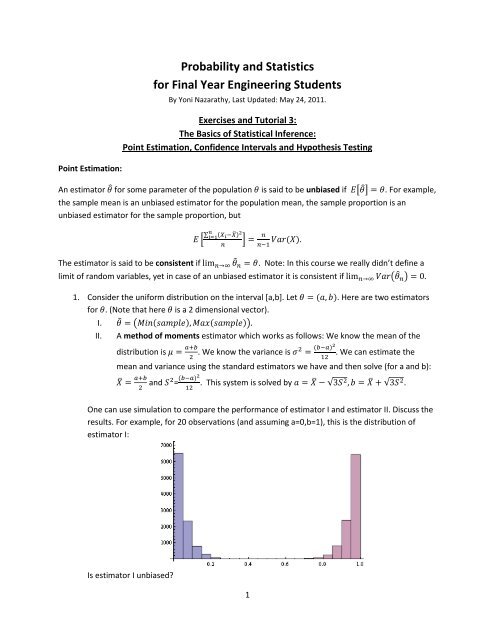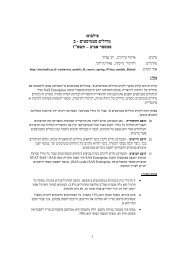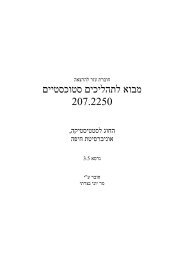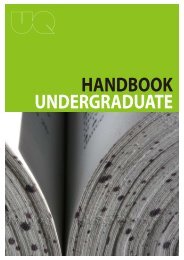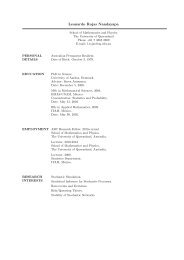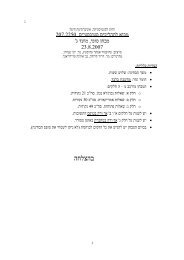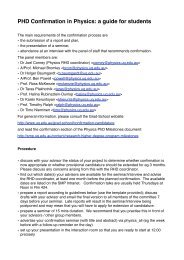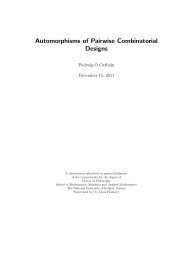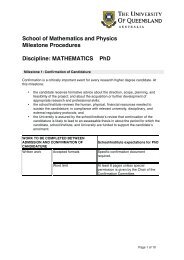Probability and Statistics for Final Year Engineering Students
Probability and Statistics for Final Year Engineering Students
Probability and Statistics for Final Year Engineering Students
Create successful ePaper yourself
Turn your PDF publications into a flip-book with our unique Google optimized e-Paper software.
Point Estimation:<br />
<strong>Probability</strong> <strong>and</strong> <strong>Statistics</strong><br />
<strong>for</strong> <strong>Final</strong> <strong>Year</strong> <strong>Engineering</strong> <strong>Students</strong><br />
By Yoni Nazarathy, Last Updated: May 24, 2011.<br />
Exercises <strong>and</strong> Tutorial 3:<br />
The Basics of Statistical Inference:<br />
Point Estimation, Confidence Intervals <strong>and</strong> Hypothesis Testing<br />
An estimator <strong>for</strong> some parameter of the population is said to be unbiased if = . For example,<br />
the sample mean is an unbiased estimator <strong>for</strong> the population mean, the sample proportion is an<br />
unbiased estimator <strong>for</strong> the sample proportion, but<br />
∑<br />
<br />
<br />
=<br />
<br />
.<br />
The estimator is said to be consistent if lim → = . Note: In this course we really didn’t define a<br />
limit of r<strong>and</strong>om variables, yet in case of an unbiased estimator it is consistent if lim → = 0.<br />
1. Consider the uni<strong>for</strong>m distribution on the interval [a,b]. Let = , . Here are two estimators<br />
<strong>for</strong> . (Note that here is a 2 dimensional vector).<br />
I. = , .<br />
II. A method of moments estimator which works as follows: We know the mean of the<br />
distribution is = <br />
. We know the variance is = <br />
. We can estimate the<br />
<br />
mean <strong>and</strong> variance using the st<strong>and</strong>ard estimators we have <strong>and</strong> then solve (<strong>for</strong> a <strong>and</strong> b):<br />
= <br />
<br />
<strong>and</strong> = <br />
. This system is solved by = − √3 , = + √3 .<br />
One can use simulation to compare the per<strong>for</strong>mance of estimator I <strong>and</strong> estimator II. Discuss the<br />
results. For example, <strong>for</strong> 20 observations (<strong>and</strong> assuming a=0,b=1), this is the distribution of<br />
estimator I:<br />
Is estimator I unbiased?<br />
1
As opposed to that, this is the distribution of estimator 2:<br />
With 100 observations, this is the distribution of estimator I:<br />
And this is the distribution of estimator II:<br />
Which of the estimators is better? (There is not a “correct” answer to this).<br />
2. Consider independent “noise” observations , , … which are assumed to have zero-mean<br />
([ ]=0). Which of the following estimators are unbiased estimators <strong>for</strong> the variance?<br />
<br />
<br />
<br />
<br />
<br />
<br />
<br />
<br />
<br />
(a) = ∑<br />
(b) ∑<br />
(c) ∑<br />
2
Confidence Intervals:<br />
A confidence interval <strong>for</strong> the population proportion is summarized as follows:<br />
̂1 − ̂<br />
̂ − <br />
√<br />
≤ ≤ ̂ + <br />
<br />
<br />
̂1 − ̂<br />
= 1 − .<br />
√<br />
Where is the x’th percentile (also called quantile) of the st<strong>and</strong>ard normal<br />
distribution: <br />
<br />
√<br />
= . Here are typical values:<br />
. = 1.645, . = 1.96, . = 2.576, . = 3.291.<br />
The above statement is approximate due to two reasons:<br />
1) The CLT is used.<br />
2) p(1-p) is replaced by ̂1 − ̂.<br />
When planning sample size<br />
s, one can use the following <strong>for</strong>mula (based on p(1-p)=1/4):<br />
∗ =<br />
<br />
<br />
<br />
<br />
<br />
<br />
<br />
4 <br />
<br />
.<br />
<br />
<br />
3. An election poll between two c<strong>and</strong>idates shows that 54% of the public supports c<strong>and</strong>idate A. If<br />
the number of questioned people is n=1000, write the following confidence intervals:<br />
I. A 90% confidence interval.<br />
II. A 95% confidence interval.<br />
III. A 99% confidence interval.<br />
IV. A 99.9% confidence interval.<br />
4. We are planning an experiment <strong>for</strong> testing the proportion of bolts that can withst<strong>and</strong> a certain<br />
load. We want to have an error of no more than 0.02 <strong>and</strong> be 99% percent confident. How many<br />
bolts are needed?<br />
5. The confidence interval <strong>for</strong>mula presented above relies on the CLT (approximates the Binomial<br />
distribution with the Normal distribution). In cases where n is not large <strong>and</strong>/or p is very close to<br />
0 or 1, the normal approximation may be too crude. In this case, one can use the exact Binomial<br />
distribution.<br />
I. Discuss how to used the Binomial distribution instead of the normal (i.e. look at the<br />
derivation of the confidence interval, what would you do differently)?<br />
3
II. Why is using the Normal distribution computationally easier?<br />
6. We did not explicitly discuss how to calculate a confidence interval <strong>for</strong> the population mean in<br />
this course (only the proportions). Yet the concepts are the same. Assume that you are reading a<br />
report by an external consultant which contains the following lines:<br />
“… R<strong>and</strong>omly sampling 143 observations we have the following 95% confidence interval <strong>for</strong> the<br />
population mean: 12.3 ± 1.1.”<br />
Which of the following statements is True:<br />
I. The sample mean was 12.3.<br />
II. It is certain that the population mean is in the range [11.2, 13.4].<br />
III. There is a 1 in 20 chance that the actual population mean is not in the range [11.2, 13.4]<br />
IV. Should the study have had a confidence level of 99% instead of 95% the confidence<br />
interval would have been wider.<br />
4
Selected Solutions:<br />
2)<br />
a) Unbiased as shown in the lecture. This is the sample variance estimator.<br />
b) ∑ <br />
= <br />
<br />
<br />
= <br />
so biased.<br />
<br />
c) ∑ <br />
<br />
<br />
<br />
= [∑ ] = ∑ [ <br />
] = <br />
[ ] = <br />
(For a RV with zero mean, the variance is the expectation of X^2).<br />
3) ̂ = 0.54.<br />
I) 0.54±0.0259 II) 0.54±0.031 III) 0.54±0.041 IV) 0.54±0.052<br />
4) 4148<br />
6) I) True, II) False III)True IV) True.<br />
5


